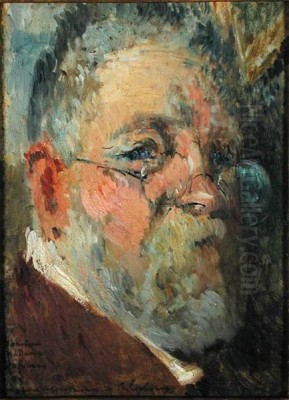
Albert Lebourg stands as a significant yet sometimes understated figure in the vibrant landscape of late 19th and early 20th-century French art. A prolific painter associated with both Impressionism and Post-Impressionism, he dedicated his long career almost exclusively to landscape painting, becoming a leading member of the Rouen School. His works are celebrated for their sensitivity to light, atmosphere, and the subtle moods of nature, particularly the changing skies and waters of the Seine River valley, Normandy, the Auvergne region, and even the distinct luminosity of North Africa. Though perhaps not as revolutionary as some of his contemporaries, Lebourg developed a distinctive and poetic style that captured the ephemeral beauty of his surroundings with remarkable consistency and dedication, leaving behind a vast oeuvre of over two thousand paintings.
Early Life and Artistic Awakening in Rouen
Albert Marie Lebourg was born on February 1, 1849, in Montfort-sur-Risle, a small town in Normandy, France. His initial path was not set towards painting; he first pursued studies in architecture at the esteemed École des Beaux-Arts in Rouen. This early training in architecture may have subtly informed his later sensitivity to structure and composition, particularly evident in his depictions of bridges, quays, and cityscapes like those featuring Notre Dame Cathedral in Paris. However, the allure of painting soon took precedence.
Lebourg transitioned to studying painting formally, also at the Rouen École des Beaux-Arts. This institution was a vital hub for artistic activity in Normandy, fostering a regional style often referred to as the École de Rouen (Rouen School). During his formative years, Lebourg came under the influence of local artists who shaped his early development. Victor Delamarre was one such figure who impacted his burgeoning interest in landscape. Another significant early influence mentioned in connection with the Rouen School was Alfred Pinson, under whom Lebourg reportedly studied. The artistic environment of Rouen, with its rich history, distinctive architecture, and proximity to the Seine River, provided ample inspiration for the young artist and laid the groundwork for his lifelong fascination with landscape.
The Algerian Experience: Light and Opportunity
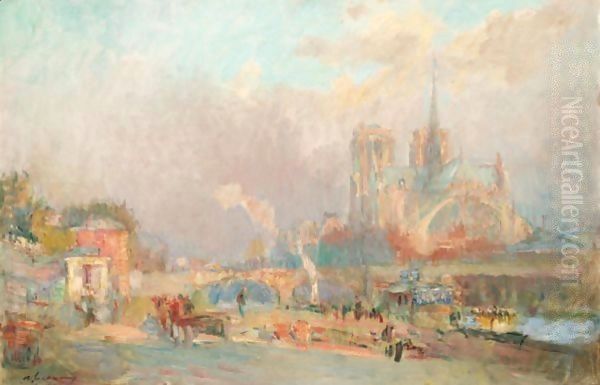
A pivotal chapter in Lebourg's early career unfolded far from the familiar landscapes of Normandy. From 1872 to 1877, with a brief return to Paris in 1873, Lebourg served as a drawing and painting professor at the Société des Beaux-Arts in Algiers, Algeria. This period proved transformative for his artistic vision. The intense, clear light of North Africa offered a stark contrast to the softer, often greyish atmosphere of northern France. Lebourg embraced this new environment, and his palette brightened considerably. He became adept at capturing the brilliant sunshine, the sharp contrasts of light and shadow, and the vibrant colours unique to the region. His Algerian works often possess a distinct clarity and warmth.
Beyond the artistic stimulation, his time in Algiers was significant for another reason. It was there, or possibly shortly after his return through his Algerian connections, that he met Jean-Georges Laperlier, a prominent collector based in Paris but with interests in Algeria. Laperlier recognized Lebourg's talent and became an important patron and friend. This encounter marked a turning point, providing Lebourg with crucial support, encouragement, and connections within the Parisian art world upon his more permanent return to France. The Algerian sojourn not only broadened his artistic horizons but also helped launch his professional career.
Return to France and Engagement with Impressionism
Upon returning definitively to France around 1877, Lebourg settled primarily between Paris and his native Normandy, particularly Rouen. He arrived back in a Paris buzzing with artistic innovation, most notably the Impressionist movement, which had already held several controversial exhibitions. Lebourg, whose own evolving style shared affinities with the Impressionists' focus on light, atmosphere, and contemporary landscape, naturally gravitated towards this circle.
He was invited to participate in the Fourth Impressionist Exhibition in 1879 and the Fifth Impressionist Exhibition in 1880. This placed him alongside core members and fellow exhibitors of the movement, including luminaries such as Claude Monet, Camille Pissarro, Edgar Degas, Alfred Sisley, Pierre-Auguste Renoir, Gustave Caillebotte, and Berthe Morisot. He maintained connections with several of these artists, particularly Pissarro and Monet, whose dedication to capturing the nuances of the French landscape resonated with his own pursuits. Records suggest he visited galleries with the collector François Depeaux, a major patron of the Rouen School and Impressionism.

Despite exhibiting with the Impressionists and sharing many of their aesthetic concerns, Lebourg never fully integrated into the core group's theoretical debates or social dynamics. He remained somewhat independent, charting his own course. While he admired figures like Édouard Manet, a precursor and inspiration for many Impressionists, and encountered others like Paul Cézanne, his path diverged from their more radical experiments in form and colour theory that characterized later developments like Post-Impressionism (think Georges Seurat or Paul Gauguin). Lebourg's connection to Impressionism was genuine, but his temperament and artistic goals led him to maintain a distinct identity, deeply rooted in observation and a lyrical response to nature.
The Essence of Lebourg's Style: Light, Water, and Atmosphere
Albert Lebourg's artistic style is best characterized as a sensitive blend of Impressionist techniques and the atmospheric concerns of the Rouen School, infused with his own poetic sensibility. His primary subject was landscape, and his overriding goal was to capture the effects of light and atmosphere on the natural and built environment. Water, particularly the River Seine, was a constant source of inspiration. He painted it endlessly, exploring its reflections, its moods under different skies, and the life along its banks in Paris, Rouen, and the surrounding countryside.
His approach incorporated key Impressionist elements: the use of broken brushwork to convey the vibrancy of light, an interest in capturing fleeting moments ('impressions'), and painting en plein air (outdoors) to directly observe nature, although he often finished works in the studio. However, his brushwork could be more delicate and less overtly fragmented than that of Monet or Pissarro at their most radical. His palette, while brightened by his Algerian experience and Impressionist associations, often favoured subtle harmonies and nuanced tonal gradations, especially when depicting the softer light of Normandy.
A defining characteristic of Lebourg's work is his mastery of atmosphere. He excelled at rendering specific weather conditions – the crisp air of a winter morning, the dampness of rain-slicked quays, the ethereal quality of mist hanging over the river, or the subtle beauty of overcast, "monochrome" days. This focus aligns him closely with the traditions of the Rouen School, which emphasized atmospheric effects and a certain lyrical or melancholic mood, perhaps influenced by earlier landscape traditions, including the work of artists like Eugène Boudin, another Normandy painter known for his sky and water studies who was a key precursor to Impressionism. Lebourg wasn't just documenting a scene; he was evoking its feeling.
Favourite Motifs and Prolific Output
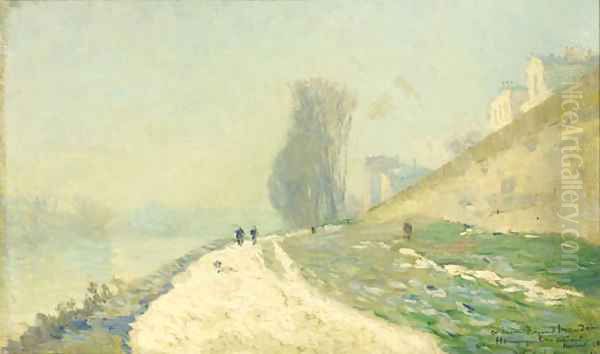
Throughout his long career, Lebourg remained remarkably consistent in his choice of subjects, returning again and again to familiar locations that he explored in depth. The Seine River was arguably his most beloved motif. He painted countless views along its course, from the bustling quays and iconic bridges of Paris (often featuring Notre Dame Cathedral) to the quieter stretches near Rouen and La Bouille. His depictions of Rouen itself, with its cathedral, old streets, and port, are also numerous and highly regarded.
Beyond the Seine valley, he frequently painted the landscapes of the Auvergne region in central France, known for its rolling hills and volcanic formations, offering a different kind of terrain and light. The Normandy coast also featured in his work. His travels provided variety, but his method remained focused on capturing the specific atmospheric conditions and light effects of each place.
Lebourg was exceptionally prolific. It is estimated that he produced over 2,000 oil paintings during his lifetime. In addition to his oils, he was also skilled in drawing, working frequently with charcoal, watercolour, and ink. These works on paper often served as studies but also stand as accomplished artworks in their own right, showcasing his fluid draughtsmanship and sensitivity to tone. This vast output speaks to a relentless work ethic and an unwavering dedication to his craft and chosen subject matter. His commitment was not to radical innovation for its own sake, but to the deep, sustained observation and rendering of the world around him.
Key Works: Glimpses into Lebourg's Vision
While selecting just a few works from such a large oeuvre is challenging, certain paintings stand out as representative of Lebourg's style and recurring themes. Notre Dame de Paris, vue du quai de la Tournelle (Notre Dame de Paris, View from the Quai de la Tournelle), existing in several versions, exemplifies his skill in capturing iconic Parisian landmarks within their atmospheric context. He masterfully renders the architecture, the river traffic, and, most importantly, the quality of the light – whether it's the soft glow of morning, the haze of afternoon, or the dampness of a rainy day – reflecting on the water and stone.
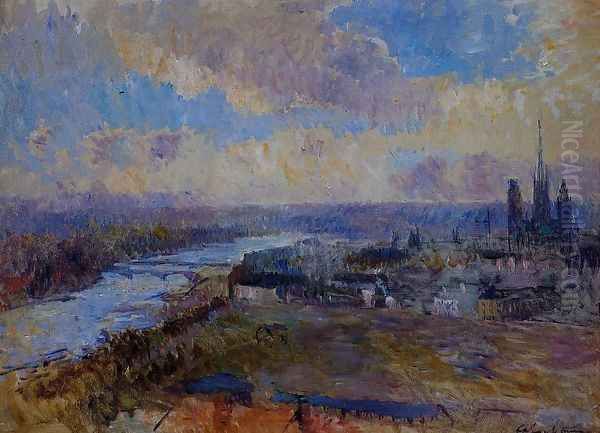
La Seine à Croisset or La Seine à La Bouille (The Seine at Croisset / La Bouille) represent his numerous depictions of the river outside the city. These works often emphasize the width of the river, the expanse of the sky, and the subtle interplay of light on the water's surface. Tugboats, barges, or sailing vessels frequently populate these scenes, adding touches of human activity without dominating the landscape. The focus remains on the atmospheric envelope, the reflections, and the tranquil or sometimes brooding mood of the river valley.
Other typical works might include snow scenes (Effet de Neige), where he explored the muted light and soft forms created by snowfall, or views of Rouen's port, capturing the masts of ships against the backdrop of the city under varying conditions. Across these works, his technique is visible: layers of paint applied with varying degrees of thickness and texture, fluid brushstrokes defining forms, and a keen eye for colour harmony, often employing blues, greys, mauves, and ochres to convey the specific light and weather.
Later Life, Recognition, and Challenges
Lebourg continued to paint actively throughout the late 19th and early 20th centuries, exhibiting regularly at the Salon des Artistes Français, of which he became a member. His personal life saw changes; after his first marriage in 1878 to Marie Guillermet (sources vary on the name, sometimes cited as Molineaux), he married Alice Lambin in 1896. He achieved significant official recognition for his contributions to French art. At the Exposition Universelle (World's Fair) in Paris in 1900, he was awarded a Silver Medal. A major retrospective exhibition of over one hundred of his works was held at the prestigious Galerie Rosenberg in Paris in 1903, cementing his reputation. That same year, he received one of France's highest honours when he was made a Chevalier de la Légion d'honneur (Knight of the Legion of Honour).
His later years were marked by a significant health challenge. In 1920, Lebourg suffered a stroke that resulted in hemiplegia, paralyzing his left side. This inevitably impacted his ability to paint with the same facility as before. Despite this setback, his dedication remained. Sources mention him remarrying his second wife in 1921, perhaps indicating a reaffirmation of vows or a legal matter following his illness, highlighting the continuation of his life and partnership under difficult circumstances. He continued to work as his health permitted, supported by his wife. Albert Lebourg passed away in Rouen, the city whose artistic life he had been so much a part of, on January 7, 1928.
Lebourg's Place in Art History: A Legacy of Light
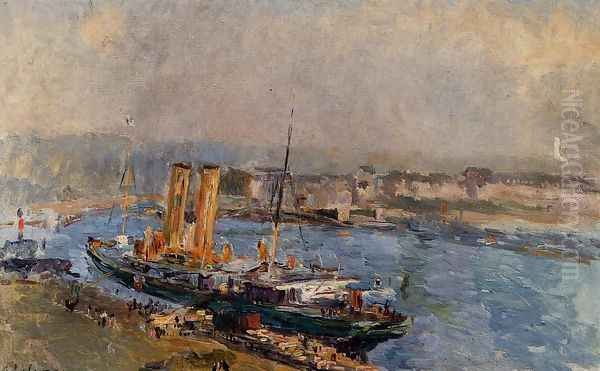
Evaluating Albert Lebourg's position in art history requires acknowledging both his strengths and the reasons why he might be less famous than the Impressionist giants with whom he exhibited. His primary contribution lies in his mastery of atmospheric landscape painting. He possessed an exceptional ability to capture the nuances of light, weather, and mood, particularly in his beloved Seine valley. His works are characterized by their sincerity, sensitivity, and often a quiet, poetic beauty. He stands as a key figure, perhaps the most prominent landscape painter, of the École de Rouen, influencing other artists in the region, such as Joseph Delattre, and mentoring students like Marie Duret.
While he adopted Impressionist techniques, he did not push the boundaries of the style as radically as Monet or Renoir, nor did he engage significantly with the structural or symbolic concerns of Post-Impressionists like Cézanne or Gauguin. His focus remained steadfastly on the faithful yet lyrical depiction of landscape. Some critics might point to a perceived lack of stylistic evolution or groundbreaking innovation compared to his more famous contemporaries. However, this consistency can also be seen as a strength – a lifelong dedication to perfecting his chosen mode of expression.
Today, Lebourg's paintings are held in numerous prestigious museum collections worldwide, including the Musée d'Orsay in Paris, the Petit Palais, the Musée des Beaux-Arts de Rouen, the Hermitage Museum in St. Petersburg, and the Art Institute of Chicago, among others. His works continue to be appreciated by collectors and perform well on the art market, attesting to their enduring appeal. He remains a testament to the depth and diversity of French landscape painting during a period of profound artistic change, a master of capturing the transient effects of light on the enduring French landscape.
Conclusion: An Enduring Vision
Albert Lebourg carved a distinct and honourable path through the complex art world of Impressionist and Post-Impressionist France. From his early training in Rouen to his formative experiences in Algiers and his engagement with the Parisian avant-garde, he developed a unique voice dedicated to the landscape. His prolific output, characterized by atmospheric sensitivity, nuanced light, and a deep affection for the Seine valley and Normandy, secured his place as a leader of the Rouen School and a respected figure among his contemporaries. While not always placed in the very front rank of innovators, his unwavering commitment to capturing the ephemeral beauty of nature resulted in a body of work that continues to resonate with viewers through its honesty, poetry, and masterful handling of light and atmosphere. Albert Lebourg remains an important painter for understanding the breadth of French landscape art at the turn of the twentieth century.